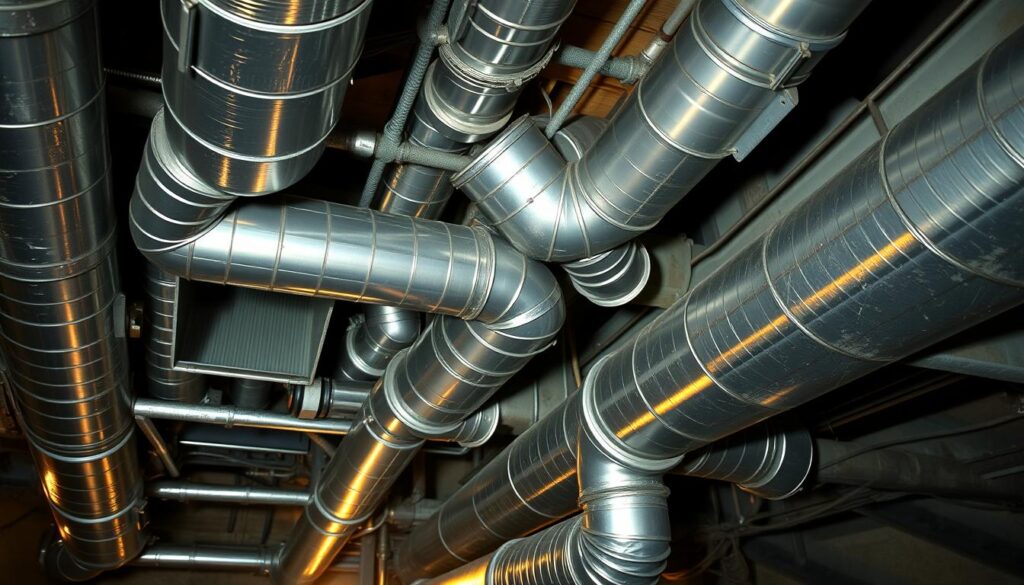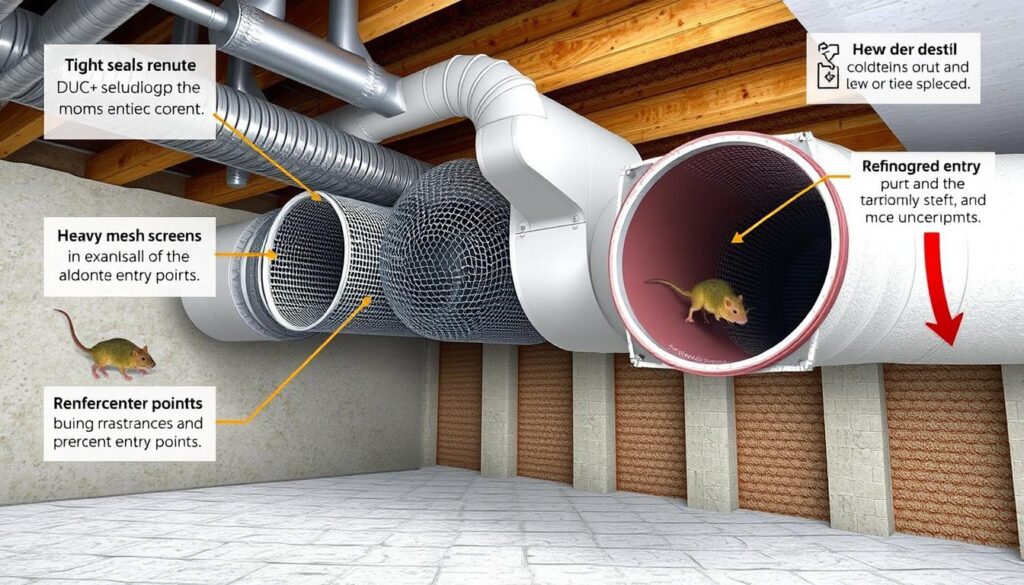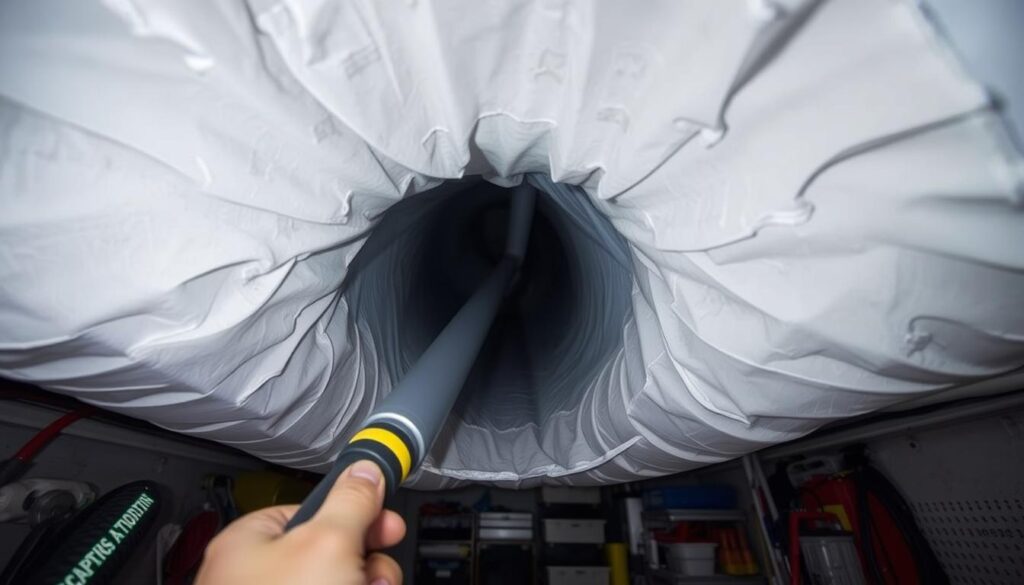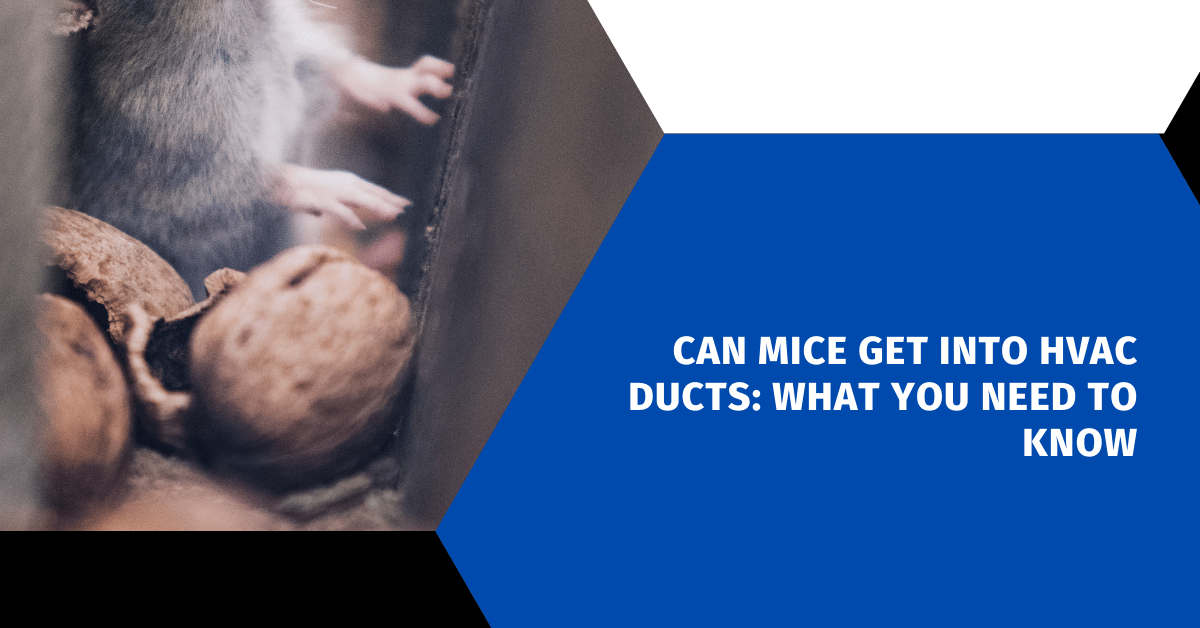Affiliate Disclosure
HVAC Guide Guys is a participant in the Amazon Services LLC Associates Program, an affiliate advertising program designed to provide a means for sites to earn advertising fees by advertising and linking to Amazon.
Can Mice Get Into HVAC Ducts? “The mouse that fears the trap has already been trapped.” – Paulo Coelho, Brazilian lyricist and novelist. This quote from Paulo Coelho introduces our look into how mice sneak into your home’s HVAC system. We’ll discuss the dangers they bring and how to keep your home mouse-free.
Mice are incredibly nimble, able to fit through tiny openings. Their bones are flexible, letting them squeeze into spaces as small as a dime. This makes them a big problem, especially in your HVAC ducts. These ducts are dark, warm, and hidden, perfect for mice looking for a safe place to live, eat, and hide.

Key Takeaways
- Mice can easily access HVAC ducts due to their flexible skeletal systems, allowing them to squeeze through small openings.
- Mice seek shelter in dark, warm spaces like ductwork, which provides access to food and protection.
- Mice in HVAC systems pose health risks, cause structural damage, and impact air quality.
- Understanding mouse behavior and prevention methods is crucial for maintaining a pest-free home environment.
- Professional pest control services may be necessary to effectively remove mice from air vents and prevent future infestations.
Table of Contents
Understanding How Mice Access Your HVAC System
Mice are great at getting into your home, including your HVAC system. They can fit through openings as small as a pencil. This lets them get in through cracks in your foundation, gaps around windows and doors, and even holes in your ductwork.
Common Entry Points for Mice
Mice look for the easiest way into your home. They use small openings and weak spots, like:
- Cracks in the foundation or exterior walls
- Gaps around windows, doors, and utility pipes
- Holes or tears in your HVAC ductwork
- Vents and flues that are not properly sealed
Why Mice Choose Ductwork as Habitat
Mice like HVAC ductwork because it’s warm, dark, and safe. It’s a great place for them to nest and find food. Plus, it lets them move around your home easily.
Mice are good climbers and can move through the HVAC system without being seen. They might not be noticed until they’re a big problem.
“Mice are a common problem for property owners, and during the winter months, they often find shelter in residential and commercial HVAC systems.”
Knowing how mice get into your HVAC system helps you stop them. You can keep your heating and cooling system working well and safely.
Explore Our HVAC Shop
Looking for top-rated HVAC tools, parts, and accessories? Visit our shop and find the perfect solution for your needs.
Visit the ShopSigns That Indicate Mice in Your Air Ducts
If you think mice might be in your home, look for signs they’re in your HVAC system. Ignoring these signs can cause more problems and health risks. Here are some common signs mice have taken over your air ducts:
- Distinct Odors from Urine and Droppings: Mouse urine and feces can make a strong, musky smell near air vents.
- Scratching or Scurrying Sounds: You might hear mice moving through walls or ceilings, especially at night.
- Visible Droppings Near Vents: Check your air vents and registers for mouse droppings, a clear sign of mice.
- Debris Buildup Inside Vents: Mice bring in nesting materials like shredded paper, leading to debris buildup in ducts.
- Occasional Squeaking Noises: You might hear mice squeaking, especially if they’ve made a nest in your HVAC system.
You might also see scratch marks on vent edges or a strong musky smell from ducts. These signs mean you have a mouse problem. It’s important to deal with these mouse infestation symptoms quickly to avoid more duct contamination and health risks.
If you see any of these signs, call a pest control service or HVAC technician. They can check your system and fix the problem. Ignoring mice in your air ducts can make things worse and risk your family’s health and comfort.
Can Mice Get Into HVAC Ducts: The Surprising Truth
Many people wonder if mice can get into their HVAC ducts. The answer is yes, they can. Mice are very good at finding small openings. They can squeeze through tiny gaps in your home’s ventilation system.
Mouse Anatomy and Flexibility
Mice have a special body shape that lets them fit into very small spaces. Their bones are flexible, and their bodies are thin. This means they can get into HVAC ducts easily.
Access Points Through Ductwork
Mice know how to find weak spots in HVAC systems. They can get in through gaps where ducts meet vents or where seams have come apart. Changes in temperature can also make ducts expand and contract, creating new ways for mice to get in.
To keep mice out of your HVAC system, check your ductwork often. Seal any cracks or openings. Also, clean your ducts regularly and use pest control to protect your home’s air system.
“Mice can squeeze through holes as narrow as the width of a pencil, making them adept at gaining entry into homes.”
Health Risks and Dangers of Mice in Ventilation
Mice in your HVAC system are a serious health threat. They can spread diseases like lymphocytic choriomeningitis (LCM), salmonellosis, leptospirosis, and monkeypox. These diseases come from their urine, droppings, and saliva. They can move through your ventilation system, putting everyone at risk.
Also, mice can make your air quality worse. Their fur, dander, and other particles can get stuck in the ductwork. This can make allergies worse and hurt people with breathing problems.
- Mice can transmit diseases such as LCM, salmonellosis, leptospirosis, and monkeypox.
- Mice introduce contaminants like urine, droppings, and saliva into the ventilation system.
- Mice fur, dander, and other particles can worsen air quality and trigger allergies.
“Mice infestations in HVAC systems can pose significant health risks to occupants, exposing them to a range of dangerous pathogens and contaminants.”
Keeping your HVAC system clean and mouse-free is key to your health. It’s important to deal with mice in your ventilation. This helps keep your air clean and stops diseases from spreading.
Explore Our HVAC Shop
Looking for top-rated HVAC tools, parts, and accessories? Visit our shop and find the perfect solution for your needs.
Visit the ShopDamage Mice Can Cause to HVAC Systems
Winter in Lincoln, Nebraska, brings cold temperatures and rodents seeking warmth. Mice often find their way into homes, especially HVAC systems. They can damage ductwork, insulation, and electrical parts.
Structural Damage to Ducts
Mice are good at chewing and can damage ductwork. This leads to air leaks and lowers HVAC efficiency. It also increases energy costs. Ducts made of materials like fiberglass or coated cardboard are especially vulnerable.
Impact on Air Quality
Mice in HVAC ducts can harm indoor air quality. They bring in nesting materials and leave behind droppings and urine. This can clog filters and damage fan blades, spreading contaminants and odors.
To protect your HVAC system, act fast if you see signs of mice. Regular maintenance and inspections by professionals can help prevent damage.
| Type of Damage | Description |
|---|---|
| Chewed Ductwork | Mice can easily gnaw through ductwork, leading to air leaks and reduced system efficiency. |
| Insulation Damage | Rodents often use insulation for nesting, compromising its effectiveness and causing airflow issues. |
| Electrical Wiring Damage | Mice can chew on electrical wires, potentially leading to system failures and fire hazards. |
| Clogged Filters and Fans | Rodent droppings and nesting materials can clog HVAC filters and damage fan blades, reducing air quality and system performance. |
Acting quickly to address mouse threats in HVAC systems is key. Homeowners in Lincoln, Nebraska, can protect their investment and ensure good air quality. This helps keep heating and cooling systems working well for years.
Prevention Methods for Keeping Mice Out
Keeping your HVAC system mouse-free is vital for your home’s comfort and health. Using rodent exclusion methods is essential to stop mice from getting into your ducts. Here are some effective ways to protect your HVAC protection:
- Seal all potential entry points with durable materials like steel wool or metal sheeting. Check gaps around pipes, wires, and outdoor vents.
- Install door sweeps and mesh screens on outdoor vents and pipes to block mice.
- Store food in airtight containers and clean often to avoid crumbs that attract rodents.
- Remove standing water near your home, as mice are attracted to it.
- Trim vegetation away from your home to remove mice hiding spots.
By using these rodent exclusion strategies, you can stop mice from getting into your HVAC system. This protects your indoor air quality. A proactive approach to HVAC protection is the best way to avoid the problems caused by rodents.

Don’t forget, regular checks and maintenance of your HVAC system are key. They help spot and fix any rodent signs early. By taking these steps, you can have a comfortable, energy-saving, and pest-free home.
Explore Our HVAC Shop
Looking for top-rated HVAC tools, parts, and accessories? Visit our shop and find the perfect solution for your needs.
Visit the ShopProfessional Solutions for Mouse Infestations
Dealing with mice in your HVAC system? It’s wise to call in the pros. They know how to get rid of rodents in your ductwork and stop them from coming back.
Pest Control Options
Experts use many methods to fight mice. They might set up traps or bait stations in your ductwork. This catches and removes the mice. They also seal off entry points to keep mice out.
HVAC Cleaning Services
Cleaning your ductwork is key when dealing with mice. HVAC cleaners inspect and clean your ducts. They remove mouse nests, droppings, and other harmful stuff.
This makes your ductwork clean and improves your air quality. They also fix any damage and suggest ways to keep your system mouse-free.
“Proper maintenance and professional intervention are key to eradicating mice from your HVAC system and ensuring a healthy, efficient home environment.”
Working with pest control and HVAC cleaners can solve your mouse problem. It keeps your home safe from future rodent issues.
Maintaining a Mouse-Free HVAC System
It’s important to keep your HVAC system free from mice. This ensures it works well and your air is clean. Regular checks are key to stopping mice and keeping your system running smoothly.
Begin with yearly HVAC checks for mouse signs like nests or chewed wires. Make sure the outdoor unit area is clean. This helps stop mice from getting in.
- Use materials like wire mesh to block mice from getting into your ducts or outdoor unit.
- Think about getting ultrasonic devices to scare mice away from your HVAC.
- Change your air filters often to keep your system running well and stop pests.
Using these preventive maintenance and rodent-proofing tips can protect your HVAC. It keeps your system safe from mice damage and health risks. Catching mouse signs early is key to a mouse-free home.
“Ignoring your HVAC can lead to expensive damage and health issues from mice. It’s smarter to prevent problems than fix them later.”

If you think you have mice in your HVAC, get a pro to check and fix it. Keeping your home mouse-free is vital for your system’s health and efficiency.
Conclusion
To keep your HVAC system safe from mice, you need a solid plan. This plan should include preventing mice, catching them early, and acting fast. Knowing how mice get into ductwork helps you protect your home.
Checking your HVAC system often, sealing holes, and using the right vent covers are key. These steps help keep mice out. Also, watch for mouse signs like sounds, droppings, and nests in your ducts. This way, you can stop problems before they get worse.
If you think mice are in your HVAC, get help from experts. Pest control pros can get rid of mice and stop them from coming back. They make sure your heating and cooling system works well for a long time.

